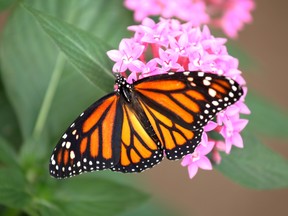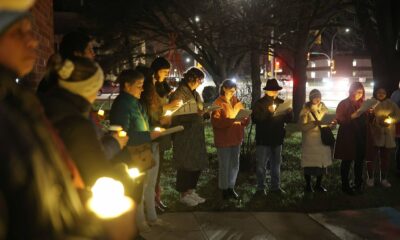Entertainment
Simple Steps to Attract Monarch Butterflies to Your Garden

Monarch butterflies, known for their stunning patterns and vital role as pollinators, can be attracted to gardens, balconies, or patios with a few simple steps. These butterflies migrate thousands of kilometres from southern Canada and northern United States to their winter habitat in Michoacán, Mexico. As the seasons change, now is the ideal time for gardeners to prepare their spaces to welcome these remarkable insects next year.
Ryan Godfrey, Botanist in Residence at WWF Canada, emphasizes that fall is the perfect moment to plant both milkweed, the essential host plant for monarch caterpillars, and various flowering plants that adult butterflies require for nourishment during their migration. Providing a diverse range of flowers throughout their life cycle increases the chances of attracting monarchs.
Essential Plants for Monarch Butterflies
According to the Canadian Wildlife Federation, Canada is home to 14 species of milkweed, which serve as the primary larval host plants for monarchs. Female monarchs lay their eggs on these plants, and the caterpillars, recognizable by their black, white, and yellow stripes, exclusively consume milkweed during their development. While some milkweed varieties can be invasive, others, like swamp milkweed, thrive in smaller spaces or pots. Godfrey recommends swamp milkweed for its beautiful pink flowers and adaptability.
“When working with native plants, mimic the natural life cycle of the plants,” Godfrey advises. Autumn is the time when milkweed seeds naturally disperse, making this a great period for planting. To ensure the seeds germinate effectively, they should be well in contact with the soil. Godfrey suggests lightly disturbing the soil to create a suitable environment for the seeds.
For those who prefer to start milkweed in spring, a simple cold stratification method can be applied. Godfrey explains that seeds need six weeks of cold, moist conditions to germinate. “I create a paper towel sandwich with seeds in the middle, moisten the towel, place it in a sealable container, and refrigerate it for six weeks,” he says.
It is important to note that most milkweed plants will not flower in their first year as they focus on establishing root systems. For quicker results, gardeners can source seedlings from local nurseries or community members who are willing to share split plants from their gardens.
Creating a Pollinator-Friendly Environment
After mating, adult monarchs require additional food sources, such as fall blooms from goldenrod and asters, to sustain their long migration. These plants can be grown in small spaces or even pots, making it feasible for anyone to contribute to local butterfly habitats. Godfrey recommends starting with just one plant to begin attracting these pollinators.
Popular aster varieties include New England, heath, and smooth blue, which are all beneficial to monarchs. Godfrey clarifies a common misconception about goldenrod, often blamed for allergies. “Research indicates that ragweed, which blooms simultaneously with goldenrod, is the actual allergen,” he states. Goldenrod pollen is sticky and insect-pollinated, making it less likely to cause allergic reactions.
Other native wildflowers, such as black-eyed susans and bee balm, also serve as food sources for monarchs. As autumn approaches, these flowers provide essential nutrition for butterflies preparing for their migration.
The Monarch Migration Journey
Currently, monarchs are likely concluding their migration from Toronto, embarking on a challenging journey of approximately 5,000 kilometres to their wintering grounds in Mexico. This generation of monarchs, often referred to as the “methuselah generation,” has a lifespan three to four times longer than their earlier generations. They pause their reproductive development during this journey, focusing solely on migration.
Upon reaching Michoacán in November, monarchs gather in the oyamel fir trees, creating a stunning visual spectacle as they cluster together for warmth throughout the winter months. They will remain in this location until March, when they begin their journey back north, mating and laying eggs along the way.
In summary, attracting monarch butterflies to your garden is a rewarding endeavor that supports biodiversity and environmental health. By planting milkweed and nectar-producing flowers, gardeners can create a welcoming habitat for these vital pollinators. With the right preparations, anyone can play a part in ensuring the survival of monarch butterflies.
-

 Politics4 weeks ago
Politics4 weeks agoSecwepemc First Nation Seeks Aboriginal Title Over Kamloops Area
-

 World5 months ago
World5 months agoScientists Unearth Ancient Antarctic Ice to Unlock Climate Secrets
-

 Entertainment5 months ago
Entertainment5 months agoTrump and McCormick to Announce $70 Billion Energy Investments
-

 Science5 months ago
Science5 months agoFour Astronauts Return to Earth After International Space Station Mission
-

 Lifestyle5 months ago
Lifestyle5 months agoTransLink Launches Food Truck Program to Boost Revenue in Vancouver
-

 Technology3 months ago
Technology3 months agoApple Notes Enhances Functionality with Markdown Support in macOS 26
-

 Lifestyle3 months ago
Lifestyle3 months agoManitoba’s Burger Champion Shines Again Amid Dining Innovations
-

 Top Stories2 months ago
Top Stories2 months agoUrgent Update: Fatal Crash on Highway 99 Claims Life of Pitt Meadows Man
-

 Politics4 months ago
Politics4 months agoUkrainian Tennis Star Elina Svitolina Faces Death Threats Online
-

 Sports5 months ago
Sports5 months agoSearch Underway for Missing Hunter Amid Hokkaido Bear Emergency
-

 Politics5 months ago
Politics5 months agoCarney Engages First Nations Leaders at Development Law Summit
-

 Technology5 months ago
Technology5 months agoFrosthaven Launches Early Access on July 31, 2025





















